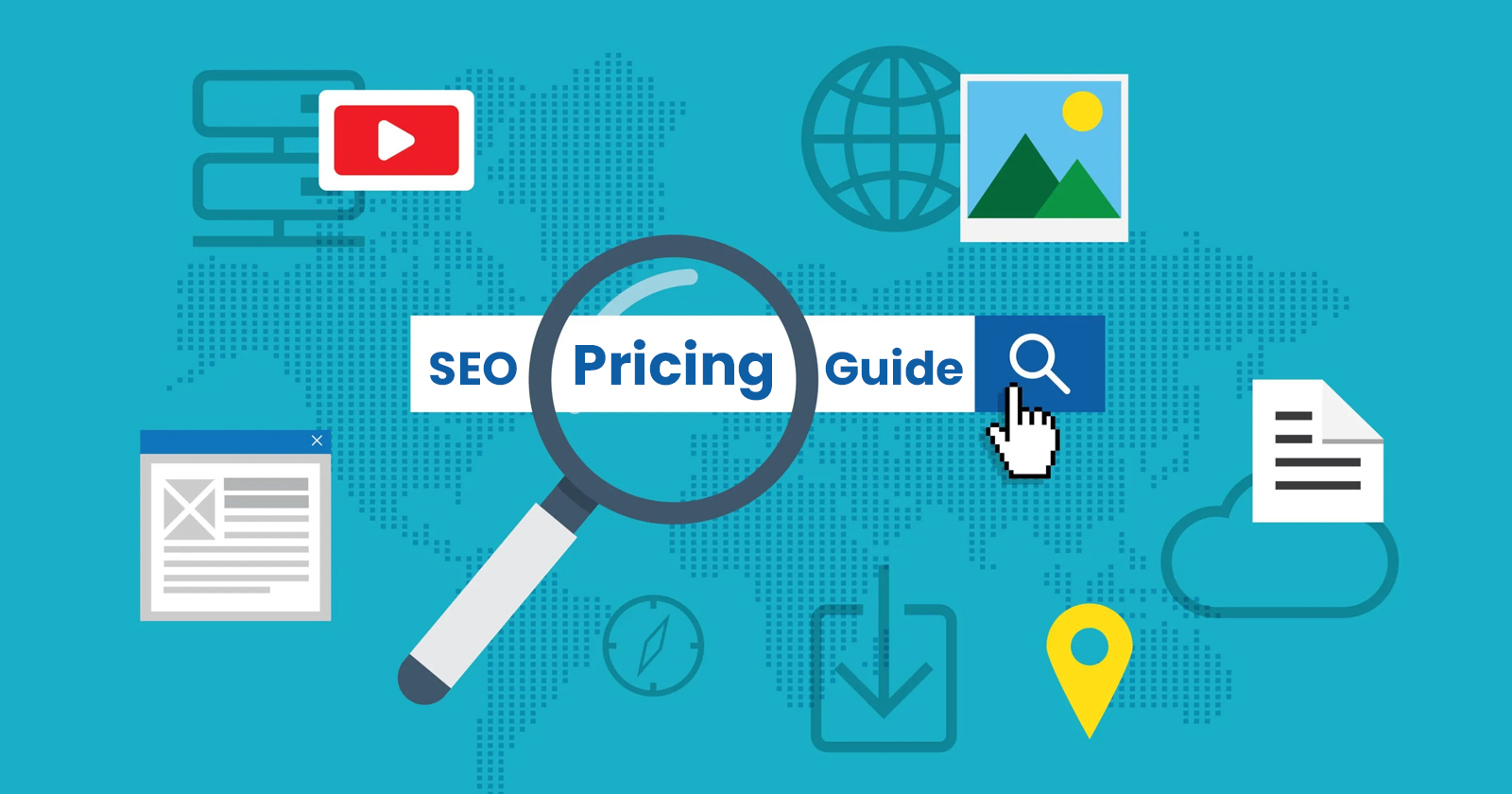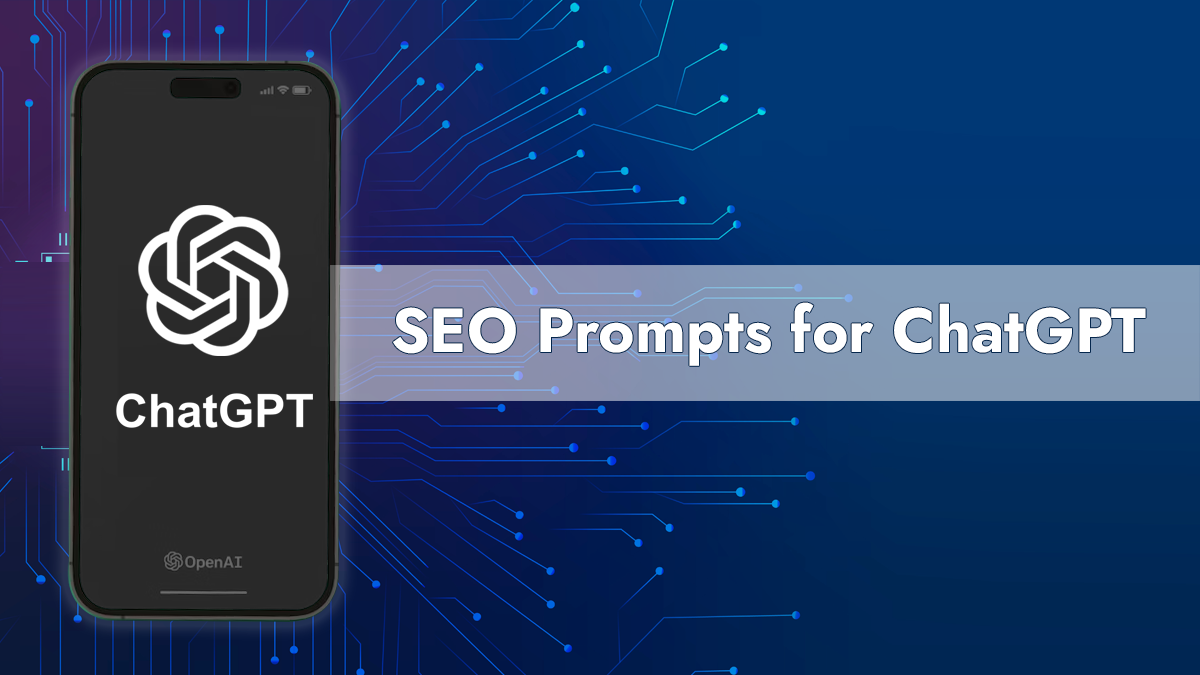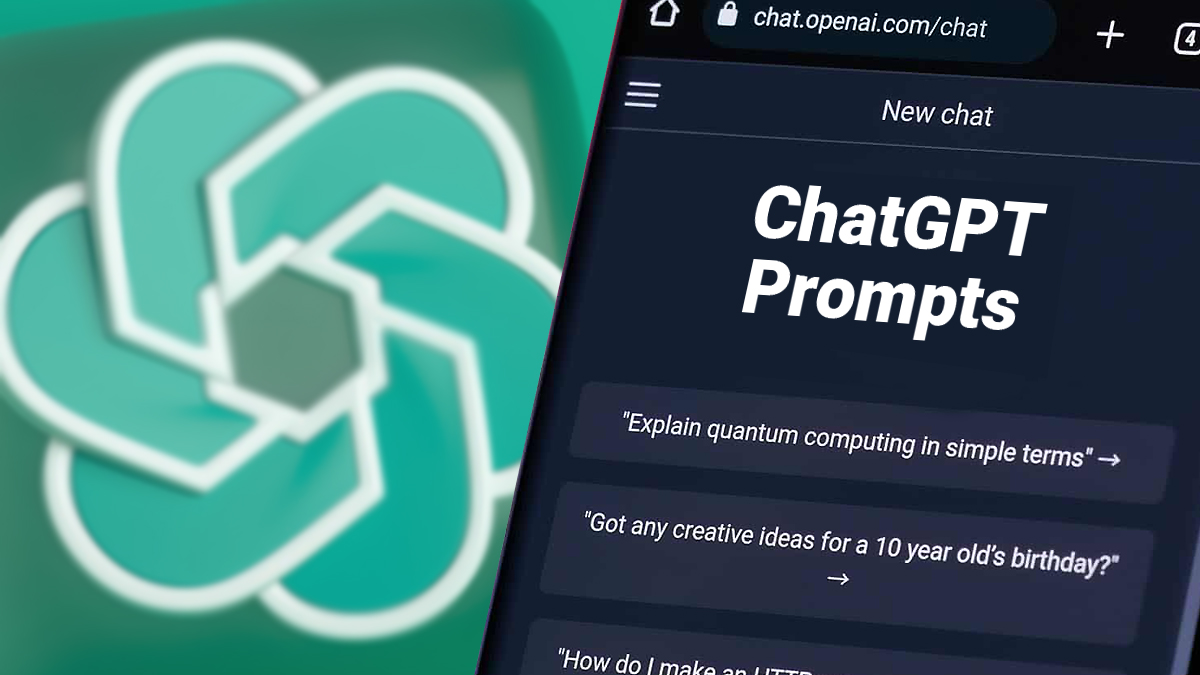As AI tools like Perplexity become more popular for giving quick and accurate answers, content creators and digital marketers want to know how to rank in Perplexity answers. Unlike regular search engines, Perplexity doesn’t just show websites; it gives summaries and mentions specific sources in its answers.
To get your content noticed, you need more than just using lots of keywords or trying to get links from other websites. It needs clear rules and organization that match how AI tools understand and choose information.
This post looks at important ways to get noticed more and have your work mentioned more in Perplexity’s answers. We will explore what makes Perplexity different, focusing on making your content easy for AI to read, accurate, and credible by using reliable sources.
We’ll also discuss how Perplexity differs from traditional search engines. If you’re a blogger, teacher, or business owner, it’s important to know how to get a good ranking in Perplexity to keep up with changes in AI-based searches.
Why Should You Include Perplexity in Your SEO and AEO Strategies?
Perplexity AI could become a popular search engine for people, now with about 10 million active users each month. There is still plenty of room to grow, but it’s obvious that users are interested.
Perplexity combines two methods, retrieval augmented generation (RAG) and a large language model (LLM), to provide users with simple and clear summaries of important topics. Perplexity’s data is always up to date and can look up current details on the internet.
This means it competes with Gemini and the new SearchGPT. Since each AI-powered search engine has a different knowledge cut-off and gets data from various places, marketers need to make special plans for using these AI searches.
SEO is changing, and AEO is the next important step that brands and marketers need to pay attention to. Users want a search experience that feels like a conversation, where they can ask follow-up questions just like they would if they were talking to someone who has the answers.
Perplexity wants to achieve that. Start a chat with someone. This change means you can’t depend on regular SEO to help you rank in AI search engines anymore. Brands and marketers have a challenge: how can they get good rankings when engines like Perplexity don’t use the same ranking system as Google?
What is User Intent and Why Does It Matter?
Understanding why a user asks a question helps your business create content that is useful and important to them. Knowing what these users want can help you make better content that fits their needs.
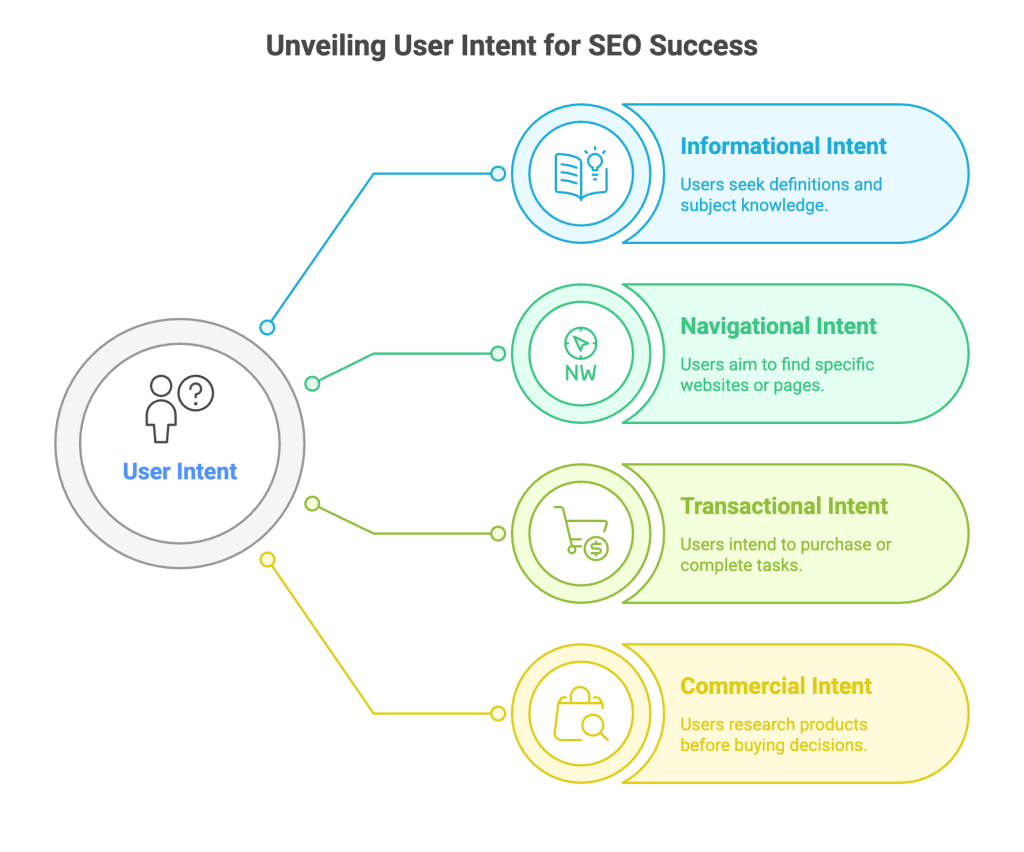
It can help you get a good rank in results pages, make it easier for users to find what they need, and lead to more sales. Remember the different types of users when improving for Perplexity and using it for SEO. There are four kinds of what users want to do:
Informational Intent – This is when someone asks a question to get definitions and learn more about a subject. For example, “What is an answer engine?”
Navigational Intent – A user is looking for a website or a specific page. For example, “Facebook login”.
Transactional Intent – The user is thinking of buying something or doing a task. For example, “I want to get a playstation”.
Commercial Intent – A user is looking up information about a product or service before deciding to buy it. For example, “Which healthcare stocks are the best in 2025?”
Difference Between Traditional Search Engines and Perplexity
As chat-based search engines like Perplexity become more common, it’s important to know how to do well in their rankings. Leveraging AI SEO services is crucial for ranking in Perplexity Answers, as they help optimize content with precision, speed, and relevance that aligns with AI-driven search algorithms.
Instead of typing in keywords like in regular search, Perplexity users ask complete questions, similar to how people speak to each other. To show how they are different:
Traditional Search: You might type “plumbing services Charlotte NC” into Google.
Perplexity: You would ask, “Which is the best plumbing service in Charlotte, NC”.
| Feature | Google Search | Perplexity AI |
| Output Format | Links list | Summarized answer + links |
| Search Type | Keyword-based | Conversational/semantic |
| Citation Style | Implicit | Explicit |
| Follow-up Questions | No memory | Context-aware memory |
Let us look in detail about the differences in conversational searches on sites like Perplexity and traditional search engine searches.

Delivery Style of Information
Traditional search engines show information by giving you a list of website links. These results are ordered using advanced algorithms that think about how important they are, how popular they are, how new they are, and how well they fit search engine rules.
The user needs to click on these links, look at each website, read the content, and gather the information by themselves. This method is good for looking at many different sources, but it can take a lot of time and not be very effective, especially if you want a quick and straightforward answer.
Perplexity AI makes it easier to get information quickly. Instead of showing a list of websites, it provides a straightforward answer to the user’s question in simple language. It gathers important information from different places and puts it together in a short summary, usually with links to learn more.
This means you don’t have to look at many different websites to find basic information. Traditional search engines are like maps of the internet, showing you where to go. But, Perplexity acts like a guide that helps you find the information you need quickly.
Query Handling and Interaction
Traditional search engines work by giving one answer for each question. You type a question, and the search engine gives you a list of related websites. However, it does not remember past questions or give answers based on previous information.
Each search is separate, so if you need more information or want to add to a past question, you have to repeat everything again by yourself. There’s no real flow to the conversation or back-and-forth exchange.
Perplexity AI makes that experience different. It has a chat-like setup where you can ask more questions that relate to the ones you asked before. For instance, if you ask, “What is climate change?” you can then ask, “How does it impact farming?” and Perplexity will know you are still talking about climate change.
This flow makes it easier for users to study complex subjects gradually and comfortably. This way of talking helps avoid repeating ourselves and makes it easier to understand without having to change every question.
This difference makes Perplexity better for learning, doing detailed research, or when you want to study a topic thoroughly over time. It works like a teacher or helpful guide, while regular search engines are like a bookshelf where you have to search for each new question without remembering anything from before.
Understanding Difficult Questions
Traditional search engines focus on keywords. They find and connect the keywords in a request with web pages that have similar words. This method works great for simple questions like “weather today” or “restaurants near me”.
But it can have a hard time with more complicated or confusing questions. If you ask a complicated question like “How do economic sanctions affect global supply chains?”, you might get answers that discuss different parts of the question but don’t really answer it directly.
The engine doesn’t really “understand” the question; it just finds similar phrases. Perplexity AI uses a big language model that can understand and answer complicated questions better by taking into account the context.
It looks at the meaning of the question and can give a smart answer that covers different parts of the question together. This helps it manage follow-up questions, detailed subjects, and complicated ideas much better than regular search.
Perplexity is made to “understand” language instead of just looking for specific words, which makes it much better for learning or analyzing situations where a deeper understanding is required.
Transparency and Source Navigation
One of the problems with regular search engines is that they make users responsible for checking the information. The search engine can give a list of websites, but it’s the user’s job to decide which ones are trustworthy, up-to-date, or biased.
Search results might show old blogs, paid ads, or pages made to rank high in search that might not have useful information. This adds extra tasks: going to different links, checking information, and making sure it is true.
On the other hand, Perplexity AI gives references in its answers, usually using reliable sources like academic papers, government websites, or trusted news outlets. The information is not only given as a summary; you can follow where it comes from.
Users can click on the sources mentioned to see where the information is from, which helps build trust and clear understanding. This format helps prevent incorrect information and saves time by directing users to trusted content.
Task Completion Efficiency
Traditional search engines are very flexible but may not work well for some tasks. For example, when you write a report or learn about something new, you usually need to look at different websites, read many articles, take notes, and then figure out what it all means.
This broken process can take a lot of time and be hard to think about. Search engines are good for finding new information, but they aren’t always quick for finding answers or putting things together. Perplexity AI is made to give information quickly.
If you want a quick summary of a science paper, an explanation of a historical event, or a comparison of two business models, Perplexity can provide it clearly and briefly in just a few seconds.
It makes the research process quicker by being both a search tool and a way to summarize information. You don’t have to switch between pages or think about combining different views, the AI takes care of that for you.
This makes Perplexity a great tool for fast learning, or any job where you need to act quickly. Traditional search engines let you explore a lot of information online, but Perplexity gives you detailed and organized answers.
Also Read: AI SEO Agency: Growing Your Online Reach
How to Optimize For Perplexity Answers?
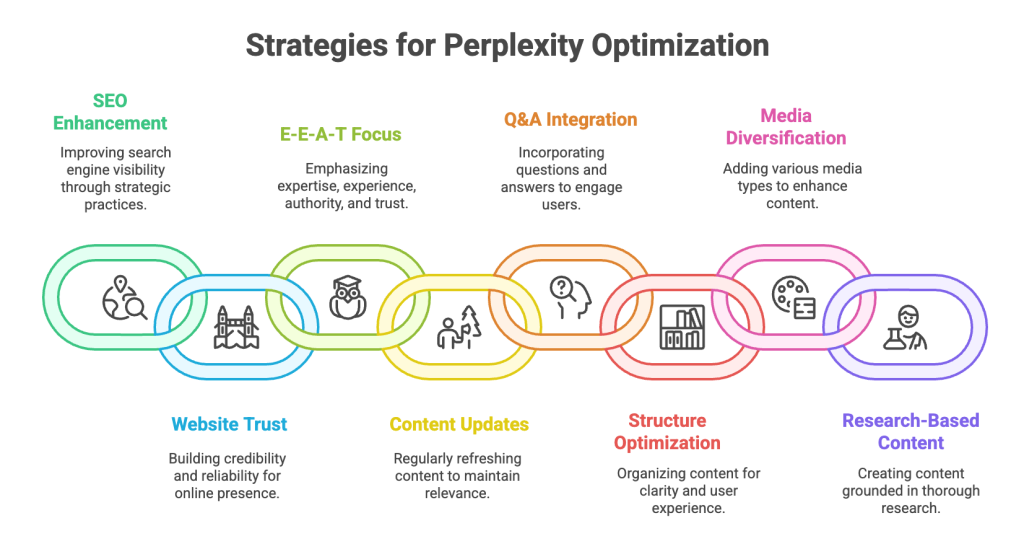
Keep Working on SEO
From our work with many answer engine campaigns, we found that companies that keep improving their SEO do better in Perplexity. That’s because Perplexity works like a search engine by:
- Using links that can be found and read by search engines to create answers.
- Referencing trusted websites that relate to a particular question.
- Concentrating on new, clear, and simple-to-understand information.
Companies that keep working on their SEO are ahead of those that don’t or have stopped improving their search engine rankings. Keep working on on-page, off-page, and technical SEO, and you’ll build a strong base for ranking well in Perplexity.
Create a Trusted Website
Compared to other answer engines, Perplexity stands out because it focuses on trust, reputation, and authority. This setup can sometimes cause big brands to take over answers, like how Wikipedia shows up for simple questions.
But for more specific questions, smaller trusted brands have a chance to shine. The best ways to create a trustworthy website are based on traditional SEO, such as:
- Creating content that can be easily shared, such as findings from a recent survey.
- Creating fun tools, like a calculator.
- Making reviews for online profiles, such as on Google Business Profile, G2, or Yelp.
Usually, improving this is very hard for brands because they need to make something special and help people find it. Every day, over 400 million terabytes of data are made on the Internet, making it hard for businesses to get noticed.
Perplexity gives lower rankings to untrustworthy sources and focuses on higher-quality, reliable websites in its ranking system. It uses AI models to check if sources are trustworthy by looking at things like their reputation, how accurate their information is, and how well it matches with confirmed data.
Content that is exaggerated, misleading, or designed just to attract clicks is rated lower by algorithms. These algorithms use signals of trust, often based on fact-checking by other sources and rules for quality search results.
When giving answers, Perplexity uses reliable sources to make sure the information is correct and fair. This system helps users get accurate information that is fair and based on facts, instead of false or overstated content.
Give Importance to E-E-A-T
E-E-A-T means Experience, Expertise, Authoritativeness, and Trustworthiness. It’s a set of guidelines created by Google to check how good online content and its sources are. E-E-A-T was first made to assess web pages in search results, but its main ideas are also really important for finding information with AI.
AI tools like Perplexity try to find not just helpful information but also trustworthy information. This involves checking content based on the principles of E-E-A-T, even if it’s not stated directly.
Perplexity uses these ideas by checking how trustworthy its information sources are. It often refers to articles written by experts, trustworthy organizations, and good content created by users on sites like Reddit and Quora.
These sources offer practical experience and helpful insights that can add to formal knowledge. Using sources directly in answers makes things clear and helps people judge how reliable the information is. This matches well with the “T” in E-E-A-T.
Also, Perplexity’s approach of guessing what users might need and offering related questions helps them explore topics more thoroughly with trustworthy advice. By gathering answers from a variety of experts and knowledgeable people, Perplexity not only follows the E-E-A-T model but also builds its own reputation as a reliable AI helper.
Update Your Content
Perplexity, like Google, wants to give users a way to search for information quickly. People can ask questions about things like the weather for the week or who won at the Academy Awards. That’s why Perplexity refreshes its index every day.
The answer engine has a Discover section where you can find the latest news. Companies that want to improve their visibility in popular or always-relevant topics can update their content to attract more attention.
Like search engine optimization, these updates should make the page better instead of just changing a few words. From the first research, you can make some plans for changing the content. When updating content, think about questions such as:
- Is the information still useful?
- What has happened since this article was published?
- Where is information missing?
Developers and marketers can use Perplexity’s API and Pro tools to add smart AI search and data retrieval to their work. With the API, developers can create custom apps that provide up-to-date answers supported by citations.
This is great for research, chatbots, or internal tools. Marketers gain valuable information about content, trends, and competitors by quickly asking reliable sources. Pro tools have better features such as unlimited questions, results you can export, and advanced filtering options.
This helps to make decisions quicker, improve content strategies, and tell stories using data. In the end, Perplexity’s tools make it easier to access reliable information, which helps technical and marketing teams work better and plan more effectively.
Use Questions and Answers
Answer engines get more questions that sound like everyday conversations than search engines do. Instead of looking up “storing espresso” on search engines, people search for “how to store espresso safely?” on sites like Perplexity.
Because of this change, businesses can gain by adding question and answer sections in their content, such as:
| Question | Answer |
| What is the safest way to store espresso? | The safest way to keep espresso is in a tight, cold container in the fridge |
| Can I keep espresso in glass bottles? | Yes. Glass bottles are better because they don’t let other flavors mix with the espresso |
| Does freezing espresso change its taste? | Yes. Freezing espresso can change its taste, texture, and freshness, making it taste bad |
To get the best results, ask clear questions and get simple, straight answers. If you know about featured snippet optimization, it’s like providing simple answers to common questions. Check the Related section in Perplexity answers to get ideas for Q&A.
Optimize Structure of Your Content
Like regular SEO, Perplexity SEO works on making the content better organized, by:
- Organizing content according to what people are looking for.
- Putting information into clear and simple titles.
- Using lists and tables to arrange information.
- Using text styles like bold, underline, or italics can help highlight important points.
These updates make the information better, which is important for search engines and answer engines. Also, visitors coming to your website from Perplexity will have a better experience, which can mean they stay longer, do small actions, and more.
Writers should always think in natural language, especially when organizing their content for both readers and AI tools like Perplexity. A simple and helpful strategy is to write headings, especially H2s and H3s, as clear and friendly questions when it makes sense.
This reflects how people look for information and how AI understands what they want. Instead of saying “Benefits of Email Marketing,” you could say “What Are the Benefits of Email Marketing?”
This makes it easier to read and helps your content match what people are searching for, making it more likely to be used in AI answers. This clear layout helps both people and Perplexity’s AI to find important information and create short summaries.
JSON-LD and FAQ schema help AI understand what a website has by organizing the information in a clear way that AI can read. JSON-LD uses pairs of keys and values to describe things, their connections, and their context.
The FAQ schema is a way of organizing information that shows questions and answers clearly. It helps AI understand that the content is helpful and can be shown in special highlights.
These schemas help improve SEO, allow for better search results, and make it easier for AI systems to find and show important information to users. They change basic information into structured, useful data.
These schemas act like a guide for the AI, clearly showing things like questions and answers in a way that machines can read. This helps Perplexity understand and use the content more easily.
Also Read: The Big 4: AI Tools for SEO Content Briefs
Add Different Types of Media
Multimedia often appears in Perplexity answers. This is because the answer system wants to give people choices. Those who prefer media can watch a video, and those who like reading can look at the text.
Companies that don’t use videos or images in their content lose a chance to connect with people. There are many free and paid ways to make videos, graphics, or photos.
You can team up with freelancers, use AI tools, and other resources to help people understand an idea, process, or service. Make it easy for people to find your brand by putting your company logo on all your pictures.
Create Research Based Content
Content is a key Perplexity ranking factor. In addition to having up-to-date information, good structure, and images, having well-researched content is also important for showing up in Perplexity’s answers.
That’s because research gives us new ideas and information. Think about the earlier question, “What is the best way to store espresso?” You can answer this while including information from a recent survey.
For example, it shows that even though glass is the best way to store espresso, X% of people said they use plastic. Perplexity doesn’t just say “Yes”. It also shares information that backs up its answer.
It cites its sources from trusted websites like Statista, and NYTimes. So, adding surveys or other research content will make you get listed in Perplexity.
- Comparison Posts
Comparison posts work well for getting mentioned in Perplexity because they match the common questions people ask, like “Which is better, X or Y?” or “What’s the difference between A and B?”
Perplexity is built to understand and answer these kinds of questions clearly, so good comparison content is really helpful. Posts that show the good and bad points, compare features side by side, or provide performance numbers are very helpful for AI-generated answers because they give clear and detailed information.
Content that is fair, neutral, and based on real facts is even more noticeable. Perplexity values sources that help users make smart choices, especially when it comes to products, tools, or methods.
If your comparison post is organized, uses trustworthy sources, and offers clear points, it’s more likely to be chosen and mentioned by others, which can help increase the visibility and reputation of your content.
- Case studies
Case studies are a powerful way to get attention and citations in Perplexity. They show real-life examples, clear results, and proof that something works, which is what users want when they look for new ideas, tools, or strategies.
When someone asks Perplexity, “What’s the best way to do X?” or “Has anyone tried Y?”, the AI searches for real stories that show the results. Case studies that explain a specific problem, show how it was solved, and share clear results provide a sense of real experience that both people and AI systems find interesting.
This matches the “Experience” and “Trustworthiness” parts of E-E-A-T. Detailed case studies, especially from reliable experts or organizations, help Perplexity give thoughtful answers based on evidence.
Adding clear information, pictures, and background helps make your case study more helpful and more likely to be used as a reliable example by others looking into similar topics.
Perplexity SEO Tips
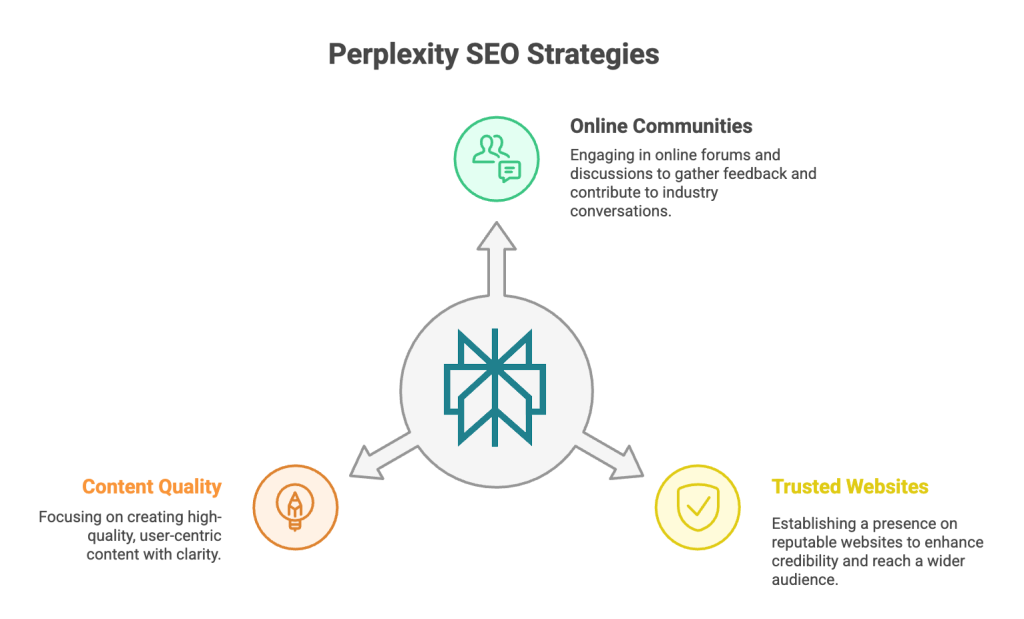
Join Online Communities
- Encourage Feedback
Encourage customers to post genuine reviews on websites after they have an experience with your business. The aim is to be seen. The more people talk about your brand on review sites, the more likely Perplexity will notice it. Many review websites focus on specific industries. By focusing on places that match your business, you’ll connect with the right people.
A main difference between Perplexity and regular search engines is how they show and organize information. Traditional search engines like Google mostly rank results based on things like how trusted a page is and how many other websites link to it, usually giving preference to well-known websites.
Perplexity looks at and often mentions good user-made posts from sites like Reddit and Quora. This helps Perplexity show true user opinions, experiences, and conversations, providing different views and details along with information from trusted sources.
Perplexity combines expert information with helpful user-generated content. This way, it provides answers that are easy to understand and include both expert views and insights from the community.
- Contribute to Discussions Related to Your Industry
Share posts on websites like Reddit and Quora, and other online groups that are related to your business. You can do this using your business name or through someone representing your business.
This helps you connect with your brand and can let you know if customers have any problems with your product. For example, if you work in healthcare, getting involved in subreddits like r/health or answering questions about your product on Quora in health-related areas will help more people see your brand.
Create spaces where people can come together and talk to customers directly. Since Perplexity often gets information from user-generated content, the more people talk about your brand, the more likely it is that Perplexity will find info about your product.
- Reply to Every Review
Answer engines like Perplexity prefer content that is focused on people and provides answers to both the main question and any possible follow-up questions. By replying to every review, you can connect with your customers and show that you care about them.
Perplexity looks at this information when choosing where to get answers for a question. When real people interact more with your brand, it makes your company seem more trustworthy.
Create a Presence on Trusted Websites
- Related to Your Field
Focus on creating content for websites that are related to your field. Find websites that get a lot of visitors, have a good reputation, and have active communities. For example, companies in the healthcare industry should make sure they are featured on trusted websites like MedlinePlus and NHS.
They can help by writing articles such as “Best Apps for Diabetes Monitoring” or “Top 10 Foods for Lactose Intolerant People”. Here are some popular types of content:
Product Reviews: Ask popular websites to review your product by paying them for a partnership.
Top 10 Lists: Try to get your name on lists that are about your business.
Comparison Posts: Create content that shows how your product is different from others. Posts that compare different products are more likely to show up on Perplexity when people ask questions about comparing the best products.
Case Studies: Show examples of how your product helped a customer or how it solves a problem in your industry.
- Interviews with Niche Experts
Just like Google, Perplexity values knowledge and skills. Working with experts to create content can help improve your chances of being recognized as a reliable source on Perplexity. Steps to think about when making content with an expert:
- List important qualifications, certificates, and skills to show their expertise
- Make sure to include links to your published content, guides, and whitepapers that discuss the topics.
Style and Quality of Content
- Quality Content
Create new posts about your brand on topics you haven’t covered before. The content should be thorough and explain topics clearly, including definitions. It should also try to clear up any potential misunderstandings. Your content should help your brand’s goals, not just create lots of content that lacks meaning.
- Focused on the User
Make content that can answer many questions all in one content piece. To get featured in Perplexity answers, your webpage should answer different questions that might be related to each other.
One way to see what questions a user might ask next is to ask Perplexity a question about the topic you’re writing about. After the content is created, there is a list of questions that are connected to it.
You can use this list to check if your content answers any of these questions. If you have one piece of content that answers several different questions, it’s more likely that perplexity will suggest your product or content to the user.
Web pages can be organized to answer different questions by using simple headers and short lists that clearly respond to these questions.
A main strategy for Perplexity is to understand what the user wants to know fully. This means not just answering the first question but also thinking ahead to what other questions they might ask afterward.
This innovative way of thinking makes Perplexity different from regular search engines that usually give separate answers that need more questions. Perplexity organizes information to help users understand a topic better and learn more.
A good example of this approach is the “Related” questions feature. This tool shows follow-up questions that come from the original question. It helps users look into related ideas, clear up any confusion, or learn more about topics they might not have considered asking about.
By using this feature, users get a better and faster way to find information, with Perplexity acting like a helpful guide that understands and responds to their changing questions. This design makes searching lead to more meaningful findings.
- Clarity
The text should be suitable for both people and AI, and encourage the use of natural language processing. This means your text can be easily read out loud or quickly summarized by AI.
High-quality content and clear content have some things in common. Using lists, clear definitions, and headings with subheadings will make your content easier to understand. Perplexity can quickly sum up this information and give users a shorter version of your content.
Use clear and simple language in your writing, and try not to use complicated terms. This makes it easier for people to read and helps AI tools summarize your content better as they work best with clear and simple language.
Using complicated or technical words can cause misunderstandings and make people less interested, especially when AI changes the content into short pieces or spoken words. Focus on using clear words, short sentences, and easy-to-understand language.
Clear writing makes it easier for people to understand and for machines to use. This helps your content connect with more readers.
Perplexity SEO Tips for AI
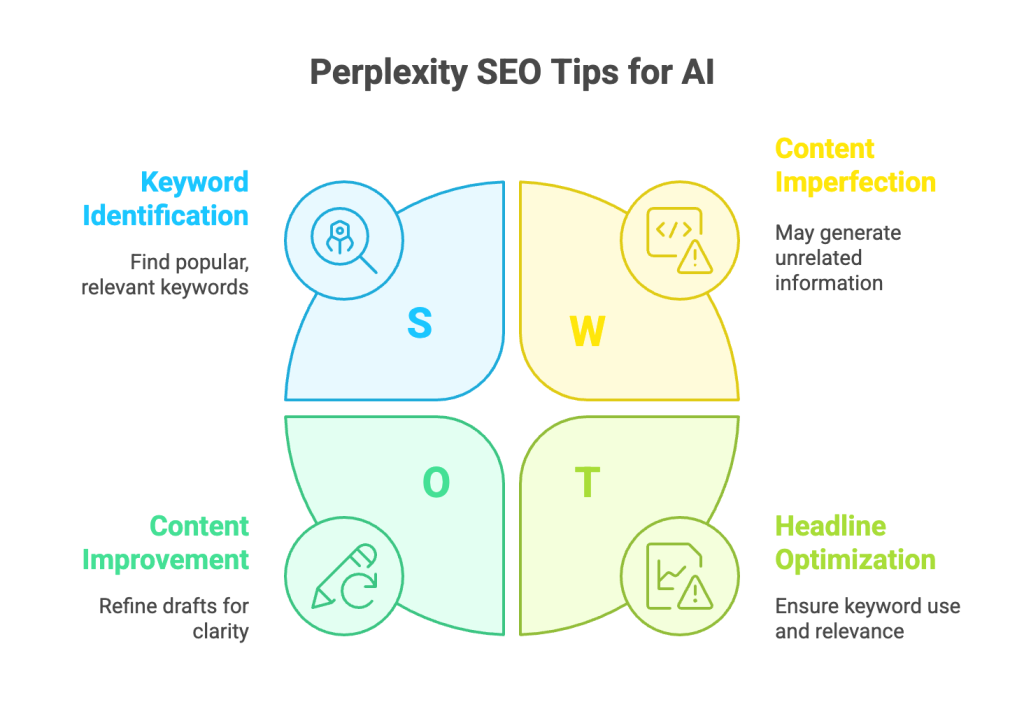
Searching for Keywords
Use Perplexity to find popular keywords in your field that are relevant to your audience. The first step is to pick what you want to focus on in Perplexity. This will customize your search for a particular situation. Make a prompt that is easy to understand and detailed. For example,
“Please perform keyword research for [describe your topic, product, or service] targeting [your audience or location, if any]. I am interested in [goals, e.g., SEO, blog topics, PPC, etc.]. Please provide a list of high-potential keywords, their search intent, and estimated search volumes and competition levels.”
To make your request clearer, add details like “low competition keywords, or high-potential keywords”. After you have a list of keywords, check the follow-up questions from Perplexity. These can help you find topics and categories you may not have thought of before.
To improve your content for Perplexity, focus on using longer, natural-sounding questions instead of just single keywords. Users usually ask Perplexity complete questions that sound like conversations, such as “How is X different from Y?” or “What is the best way to do Z?” instead of just using single terms.
Thinking about these real questions while you write helps your content match what people are looking for and makes it more likely to be used as a direct answer. This doesn’t mean you should forget about keywords. Instead, it means you should include them in clear, detailed questions that show how people really look for information today.
Understand What Users Want
First, come up with a question about your brand or the products you sell. Choose one of the four types of users you want to focus on. Users ask questions to find information, get directions, make purchases, or learn about businesses.
Ask Perplexity these questions, and it will give you a summary with links. At the bottom of the page, there is a list of extra questions that users might ask about your question. This shows what things people want to look for.
Make Sure the Content is Clear
Use Perplexity to see how well your content will do based on specific SEO rules. Give Perplexity a list of things to look for and ask it to see if it suggests better headlines or if anything important is missing.
It’s important to check anything that Perplexity writes for you. It’s not perfect, and while it’s gotten better, it can still come up with unrelated information. Here are things you can add to your checklist if you want Perplexity to review your headline:
- Keyword use: Make sure to include your main keyword.
- Length optimization: The headline should be a maximum of 55 characters.
- Relevance: Make sure the title matches the topic of your content.
- Uniqueness: Use Perplexity to find other headlines that have the same title.
Refine Your Draft
Writers can use Perplexity as a helpful tool after they finish writing to see how well their work meets readers’ needs. A good way to get help is by asking Perplexity the types of questions your article aims to answer.
If people refer to your content or similar answers come up, it means your work is useful to users and the AI. This can show any areas that are missing or not clear and need improvement.
If you’re using Perplexity Pro, it can write in more helpful ways. You can copy parts of your draft and ask for help on how clear, brief, or friendly it is. Perplexity can offer different ways to say certain sentences or paragraphs.
This helps you make your writing easier to read while keeping your style. Using Perplexity this way makes it smart, acting like a good editor and audience proxy. It helps make sure your content is correct, interesting, and well-organized.
To Conclude
Ranking in Perplexity isn’t just about outsmarting an algorithm, it’s about being really helpful, reliable, and easy to understand. Because Perplexity AI uses accurate, well-structured, and reliable information, you should focus more on the quality of the information instead of just using keywords a lot.
Content that is organized with clear titles, short explanations, and trustworthy sources is more likely to be used by AI. Also, being mentioned by other trusted sources and having a strong website can help you become more visible in Perplexity’s system.
As AI tools change the way people find information, focusing on Perplexity presents a new opportunity for planning content. Instead of just thinking about ranking in search, see it as a clearer and more direct chat between people and the information they want.
If you make your content work well with the given strategies, you’ll help ensure that more people see it in the future. If you find it difficult, you can contact our AI SEO agency, and we will be happy to help. This will also make you a trusted source in a time when being accurate and dependable is really important.
FAQs
What does it mean to “rank” in Perplexity?
Ranking in Perplexity means that your content is chosen and mentioned as a source in the answers that Perplexity gives to users. Unlike regular search engines that show a list of links to click on, Perplexity provides direct answers and includes notes or references to the sources it used. If your website, blog, or article is selected, it means the AI has found your content to be correct, trustworthy, and related to the topic.
How does Perplexity decide which sources to mention?
Perplexity uses big language models to read and understand a lot of information from the internet. It checks the content for how clear it is, if the information is true, if it answers the question, and if the website is trustworthy. Websites that have a strong reputation, good links from other sites, and regularly publish quality content are usually preferred. However, smaller sites with well-written and focused content can also be recognized.
Does SEO still matter for Perplexity?
Old SEO methods like using the right keywords and getting links to your site still matter because they help improve how visible and trustworthy your site is on the internet. Perplexity pays more attention to how helpful and reliable your content is for the person using it. This means that good writing, correct information, and a well-organized structure are more important than cramming in a lot of keywords.
Can blogs or small websites show up in Perplexity?
One special advantage of Perplexity’s AI system is that it can judge content by how good it is, not just how popular it is. This means that a short blog post can rank higher than a big magazine article if the AI thinks it’s more helpful or easier to understand. The important thing is that your content answers common questions people have, is organized well, and is backed up by trustworthy information or facts.
Does the domain authority affect the ranking in Perplexity?
Yes, but it’s different from how regular search engines work. Domain authority helps show how trustworthy your website is, and websites that are trusted are more likely to be linked to by others. But Perplexity’s AI also looks at the real content and doesn’t just depend on who is in charge.





